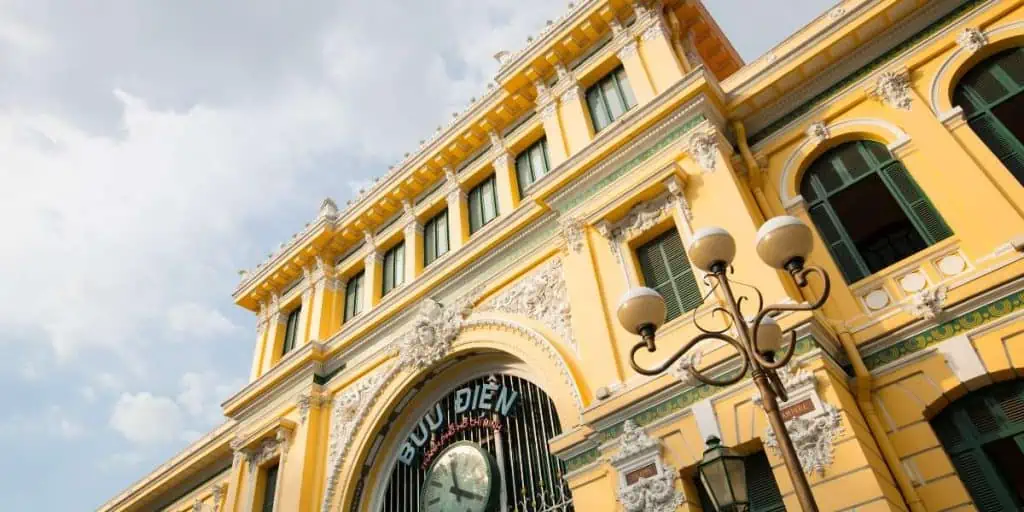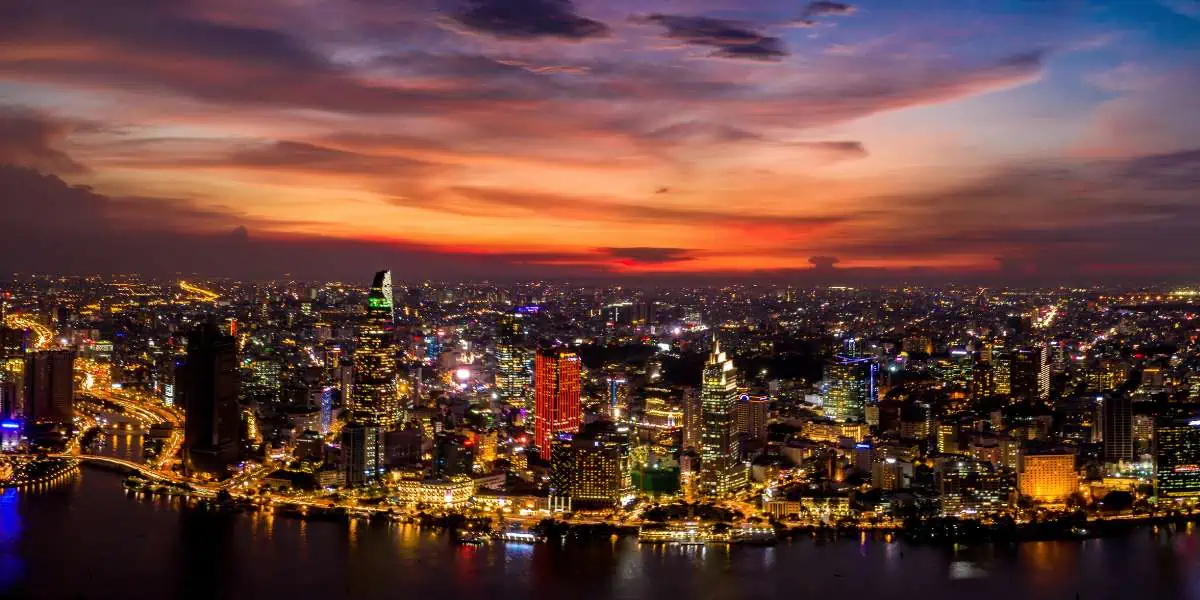Embark on a journey through the vibrant city of Ho Chi Minh City, where modern architectural marvels stand as testaments to creativity and innovation. Discover the captivating skyline, explore iconic landmarks, and delve into the fusion of tradition and modernity that defines Saigon’s architectural landscape.
Introduction
Ho Chi Minh City, affectionately known as Saigon, boasts an ever-evolving skyline that aptly captures the essence of this bustling metropolis. Dynamic and cosmopolitan, Saigon’s landscape is defined by sleek skyscrapers and contemporary buildings that stand side-by-side with French colonial architectures and traditional Vietnamese structures.
This harmonious blend of old and new, traditional and modern, is what makes Saigon’s architecture so captivating. Modern engineering marvels employ cutting-edge technologies and creative designs, while subtle incorporations of local motifs celebrate Vietnam’s rich heritage. Saigon has embraced innovation while preserving its vibrant culture and traditions.
The city’s skyline reflects this fusion at every turn. Ancient pagodas share space with financial towers that dot the horizon, while 19th century opera houses contrast award-winning museums. Saigon’s architectural feats showcase the city’s memories and aspirations – its pride in its past and its dynamic vision of the future.
Iconic Landmarks of Saigon’s Skyline
Bitexco Financial Tower
The 68-storey, 262-metre-tall Bitexco Financial Tower is one of Saigon’s most iconic landmarks. Inspired by Vietnam’s national flower – the lotus, the skyscraper resembles a lithe lotus stem rising up into the sky.
The petal-shaped helipad on the 52nd floor further emphasizes the floral motif. Architect Carlos Zapata ingeniously incorporated natural design elements to create this symbol of prosperity. Bitexco Tower houses office spaces, shops, restaurants, and an observation deck. The Skydeck on the 49th floor offers 360-degree views of the magnificent city.
This architectural marvel has put Vietnam on the global map of innovative engineering and sturdy construction. It represents Saigon’s economic prosperity and rapid development.
Landmark 81
Another one of Saigon’s architectural icons is Landmark 81 – the tallest building in Vietnam standing at 461.5 metres. Currently the 14th tallest building in the world, Landmark 81 has over 80,000 square metres of floor space occupied by office areas, luxury hotels and apartments, observation decks, and a rooftop bar.
The building was designed by British architectural firm Atkins and bears a contemporary style with four tapering segments interspersed with generous green spaces. Landmark 81 employs state-of-the-art technologies like ultra-high-speed elevators, advanced mechanical cooling systems, and double-glazed glass to control wind pressure.
This towering marvel offering panoramic views of Saigon is a testament to visionary design and engineering ingenuity. It has become a new landmark in the city’s continually evolving skyline.
Saigon Opera House
No discussion of Saigon’s architectural wonders is complete without mentioning the magnificent Saigon Opera House. Built in 1897 by two French architects, the Opera House bears a Classical revival style with Vietnamese motifs blended into its imperial façade.
The exterior features a trio of arches, avant-corps, pilasters, balustrades and winding staircases, while the interiors are embellished with Buddhist symbols, Vietnamese masks and paintings. From its architectural style to the smallest details, the Saigon Opera House is a beautiful fusion of French and Vietnamese cultures.
This red brick marvel continues to host a variety of theatre performances, cultural events and entertainment programs. It stands as a monument to Saigon’s enduring artistic heritage.
Ho Chi Minh City Museum of Fine Arts
In stark contrast to the classical Opera House is the contemporary concrete, steel and glass structure housing the Ho Chi Minh City Museum of Fine Arts. Designed by architect Vo Trong Nghia, the building integrates tree-covered voids within its floors to allow natural light and ventilation.
The museum layout navigates around a central spiral staircase that snakes through the five-storey building. Galleries exhibit avant-garde paintings, sculptures and installations as well as traditional lacquerware and woodworks. The juxtaposition of classical and contemporary artefacts against modern architecture encapsulates how Saigon embraces both tradition and modernity.
The Fusion of Tradition and Modernity
Beyond these iconic structures, Saigon flaunts subtle fusion of tradition and modernity across its architectural landscape. Sleek high-rises bear spread out “tube houses” typical of Vietnamese architecture, with indoor courtyards, front rooms opening into the streets outside, and long rectangular shapes to minimize sun exposure.
Contemporary buildings incorporate “mat cashews” or lookout towers inspired from ancient Vietnamese structures. Riverside resorts and hotels feature ceramic-tiled roofs, pointed edges, multi-tiered levels and other traditional motifs. The city’s imperial past peeks through even ultra-modern cafes, shops and commercial spaces embracing both global and local elements.
Saigon’s unique East-meets-West architecture is most evident across District 1 and along the iconic Dong Khoi Street. Old French villas with yellow plaster walls, louvered windows and tiled roofs stand alongside avant-garde glass tower blocks. Across town, the Western-inspired Independence Palace and Notre Dame Cathedral hold their own against traditional pagodas like Jade Emperor and Giac Lam.
As Saigon continues its exponential growth as a cosmopolitan centre of finance and commerce, its architecture reflects its aspirations of being a global city without losing sight of its history and heritage. The skyline captures how the city not just accepts but Also integrates diverse international influences with its intrinsic Vietnamese soul.
Modern buildings employ cutting-edge technologies from digital tools in structural design to 3D simulations assessing urban integration and geo-contextual optimization. Saigon has seven buildings in the global Top 100 skyscrapers even as traditional construction, materials and techniques characterize the tube houses occupying their shadows.
The city’s architecture thus stands at a crossroad between its memories of the past and its dynamic vision of the future.
Exploring Saigon’s Architectural Gems

Every hidden corner of Vietnam’s largest city offers unexpected discoveries for architecture enthusiasts. Beyond established tourist attractions, each quaint alleyway and bustling avenue hides architectural gems worth exploring.
1. French Colonial Buildings
Saigon boasts over 800 French colonial buildings constructed between 1860s to the 1950s during French occupation. Admire the beautifully preserved colonial architecture through sites like the Central Post Office with its intricate vaulted ceiling; Ho Chi Minh City Hall (formerly Hotel de Ville) with its ornate façade sporting iron lacework, shuttered windows and a corner tower; or the luxury Sofitel Saigon Plaza hotel ensconced within the historic Metropole Building.
2. Communist and Resistance Infrastructure
The Independence Palace is an iconic site that chronicles Vietnam’s colonial history and communist party’s rise. Designed by Paris-educated Vietnamese architect Ngo Viet Thu, this 1960s structure incorporates modern design with Vietnamese motifs like an overhanging roof. Just a few blocks lie the War Remnants Museum documenting Vietnam’s resistance and independence struggle through historic tanks, aircraft and weapons on display amidst architecturally striking buildings.
3. Modern Marvels
Beyond past wonders, contemporary masterpieces like Diamond Plaza and Saigon One Tower astound with their towering height, massive dimensions and avant-garde design. The award-winning Deutsches Haus Ho Chi Minh City with its geometric façade covered in solar cells, the lotus-shaped Voronezh Restaurant, and arc-shaped Radius Building represent architectural innovation through form and functionality.
4. Religious Structures
Places of worship also contribute to Saigon’s beautiful architectural mosaic. The brightly coloured Jade Emperor Pagoda with its towering dragon statues, incense-filled main hall and extensive woodwork; the Cantonese Thien Hau Pagoda featuring intricate carvings, sculptures and frescoes; the miniature replica of Rome’s St Peter’s Square in the form of the Notre Dame Cathedral – each tell a unique spiritual and cultural story through design.
5. Creative Hubs
Galleries, boutiques, cafes and creative parks across downtown Saigon highlight how contemporary urban planning preserves architectural heritage through restoration and adaptive reuse. The Factory Contemporary Arts Centre features an avant-garde façade against a 19th century warehouse framework. The Sense City complex houses swanky restaurants alongside art galleries within a French colonial structure. New projects like Vinhomes Golden River Ba Son integrate parks and green zones across residential skyscrapers and commercial spaces.
Conclusion
Saigon continues to mesmerize with its architectural wonders spanning centuries, cultures and styles while organically weaving them into the city’s continually evolving mosaic. Imperial palaces rub shoulders with 21st century skyscrapers just as ancient pagodas hold their own against futuristic commercial spaces.





